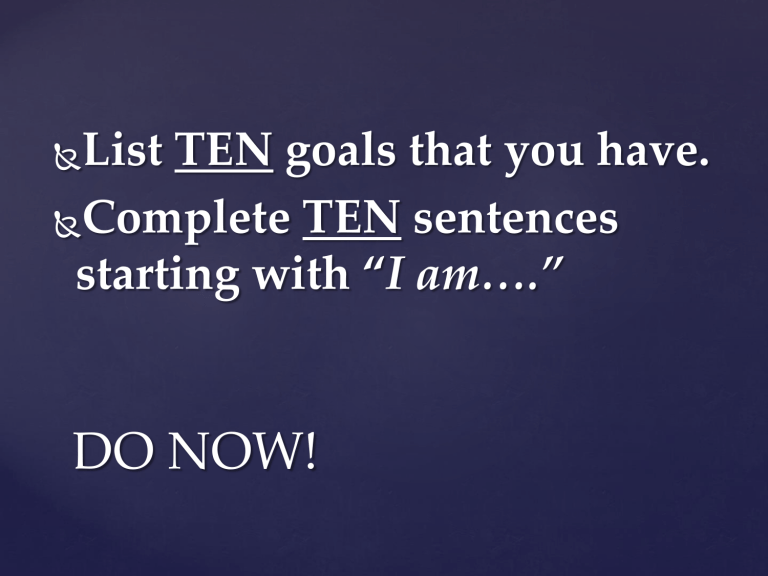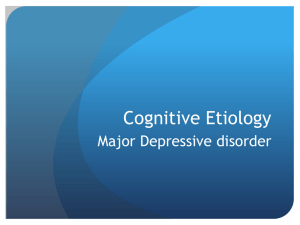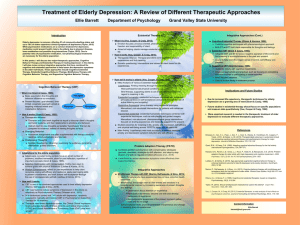Affective Disorders

List TEN goals that you have.
Complete TEN sentences starting with “I am….”
DO NOW!
Affective Disorders
{
DEPRESSION
Affective (Emotional)
- Loss of interest/pleasure
- Worthlessness
- Guilt
Behavioral
- Passivity
- Lack of initiative
Cognitive (Thinking)
- Difficulty concentrating
- Negative thoughts
- Misplaced blame
- Low self-esteem
- Hopelessness
- Indecisiveness
Somatic (Physical)
- Insomnia/hypersomnia
- Appetite change
- Weight loss/gain
- Loss of energy
- Low libido (sex drive)
Symptomology
Client must present one A list symptom and at least 4 others:
A LIST SYMPTOMS:
Depressed mood
Loss of interest in activities that used to be enjoyed
B LIST SYMPTOMS:
Insomnia/hypersomnia
Appetite change
Loss of energy
Feeling worthless
Difficulty concentrating
Suicidal thoughts
Symptomology
Major Depressive
Disorder
what we normally think of!
Dystemia
‘lite’ depression
Seasonal Affective
Disorder (S.A.D.)
winter =
Bipolar Disorder-
½ depression, ½ mania..
Different types!
TYPES
AT RISK POPULATIONS
2-3x more common in women
15% of the population is depressed at one point in their lifetime
Higher in lower economic bracket
Higher in Jewish males (= to women)
17 million Americans a year
PROGNOSIS
Reccurent in 80% of those who experience at least one depressive episode
Average of 4 episodes
Prevalance Rates
Role of Genetics
Moffit (2006): followed 1000+ NZ subjects from 1972-2006. Recorded life stressors. Looked at LONG vs SHORT serotonin transporter gene
(5-HTT)
Depression after 4+ stressful experiences in 5 years:
33% with short gene depressed
17% with long gene depressed
So… Long gene works BETTER!
Role of Neurotransmitters
↓ serotonin = ↑ chance of depression
Role of Hormones
Diathesis Stress Model
Stress releases the hormone CORTISOL, which is linked with depression
Vulnerability (genes, prenatal effects) + STRESS = ↑ chance of depression
Biological Etiology (Cause)
Role of Cognitions
Thoughts of hopelessness, pessimistic thinking, low self esteem.
Depresses cognitions, cognitive distortions, and irrational beliefs produce disturbances in mood.
Alloy (1999)
Followed Americans in their twenties. Thinking style was tested and students were placed into positive or negative thinking groups
After 6 years, only 1% of those in the positive thinking group had developed depression, 17% of the negative thinking group
Cognitive Etiology
Thoughts
Feelings Actions
Role of Culture
Individualistic Cultures: value the individual over the group
Symptoms: sad, hopeless, worthless, loss of interest
Collectivist Cultures: value the group/whole over the individual
Symptoms: headache, tired, stomachache, backache
Sociocultural Etiology
Drug Therapy
Types of medication
Mood stabilizers- help even out highs/lows
Antidepressants- help lift the symptoms of depression
Antipsychotics- primarily treat symptoms of mania
Thase (2003)
Meta-analysis of 7 clinical trials looking at remission of depression rates
SSRIs (Prozac) = 35%
SNRI (Effexor) = 45%
Placebo = 25%
Significance: placebo effect almost as effective! We haven’t perfected antidepressants….
Treatment Options: Biological!
Electroconvulsive Therapy (ECT)
Applies a small amount of electrical current to the brain
Causes mild seizures, which changes brain chemistry
Effective in treating SEVERE depression
Controversial!!
Side effects- confusion and memory loss
Treatment Options: Biological!
Cognitive Behavioral Therapy (CBT)
Combines cognitive and behavioral therapy
Goal: change the automatic thoughts that contribute to negative emotions
Cognitive Therapy:
Focuses on how thought affect emotions and behaviors
Behavioral Therapy:
Concentrates on changing a person’s reaction to challenging situations
Hollon (2005)
Patients relapsed when stopped meds = 76%
Patients relapsed when given CBT = 31%
Significance:
CBT helps people learn to COPE
Medicine covers symptoms, doesn’t cure/treat the CAUSE.







